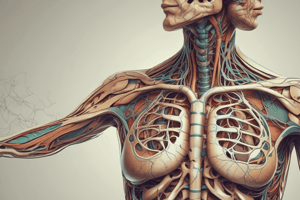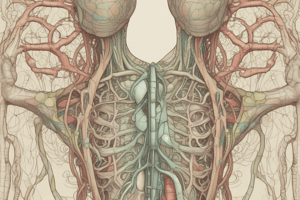Podcast
Questions and Answers
What is the primary function of valves in lymphatic vessels?
What is the primary function of valves in lymphatic vessels?
- To increase heart rate
- To reduce body temperature
- To prevent backflow of lymph within the lymphatic drainage system (correct)
- To increase blood pressure
What is the mechanism by which skeletal muscle pump assists with lymph return?
What is the mechanism by which skeletal muscle pump assists with lymph return?
- Contraction of diaphragm
- Contraction of smooth muscle
- Contraction of cardiac muscle
- Contraction of skeletal muscles in the limbs (correct)
What is the consequence of respiratory pump on lymph flow?
What is the consequence of respiratory pump on lymph flow?
- It creates a pressure gradient that assists in the flow of lymph (correct)
- It increases heart rate
- It reduces blood pressure
- It increases internal thoracic pressure
What is the function of lymph nodes in the lymphatic pathway?
What is the function of lymph nodes in the lymphatic pathway?
How many lymph nodes are approximately found in the human body?
How many lymph nodes are approximately found in the human body?
What type of cells are activated in lymph nodes to respond to foreign antigens?
What type of cells are activated in lymph nodes to respond to foreign antigens?
What is the location of lymph nodules?
What is the location of lymph nodules?
What are the two types of immunoprotective cell lines hosted in lymph nodes?
What are the two types of immunoprotective cell lines hosted in lymph nodes?
What is the primary function of the lymphatic system in relation to fats and fat-soluble vitamins?
What is the primary function of the lymphatic system in relation to fats and fat-soluble vitamins?
What is the characteristic of lymphatic capillaries that allows fluid to enter?
What is the characteristic of lymphatic capillaries that allows fluid to enter?
What is the main difference between lymph vessels and veins?
What is the main difference between lymph vessels and veins?
What is the function of the skeletal muscle pump in the lymphatic system?
What is the function of the skeletal muscle pump in the lymphatic system?
What is the function of the respiratory pump in the lymphatic system?
What is the function of the respiratory pump in the lymphatic system?
What is the name of the lymphatic duct that drains the right half of the body superior to the diaphragm?
What is the name of the lymphatic duct that drains the right half of the body superior to the diaphragm?
What is the main function of lymph nodules?
What is the main function of lymph nodules?
What is the main difference between a lymph node and a lymph nodule?
What is the main difference between a lymph node and a lymph nodule?
What are the tonsils?
What are the tonsils?
What is the result of a tonsillectomy?
What is the result of a tonsillectomy?
What is the purpose of redundant structures in the human body?
What is the purpose of redundant structures in the human body?
What is the typical first symptom of Hodgkin's disease?
What is the typical first symptom of Hodgkin's disease?
What is required for the diagnosis of Hodgkin's disease?
What is required for the diagnosis of Hodgkin's disease?
What is the treatment of Hodgkin's disease?
What is the treatment of Hodgkin's disease?
What is the primary function of the lymphatic system?
What is the primary function of the lymphatic system?
Which of the following organs is responsible for T-lymphocyte maturation?
Which of the following organs is responsible for T-lymphocyte maturation?
What is the term for the fluid transported by the lymphatic vessels?
What is the term for the fluid transported by the lymphatic vessels?
Which of the following is a function of lymph nodes?
Which of the following is a function of lymph nodes?
What would happen if the lymphatic system did not return tissue fluid to the blood?
What would happen if the lymphatic system did not return tissue fluid to the blood?
Which of the following organs is responsible for filtering blood plasma?
Which of the following organs is responsible for filtering blood plasma?
What is the primary function of the spleen?
What is the primary function of the spleen?
What is the term for the process by which tissue fluid returns to the blood in capillaries?
What is the term for the process by which tissue fluid returns to the blood in capillaries?
What is the location of the thymus in the thorax?
What is the location of the thymus in the thorax?
What is the primary function of the thymus?
What is the primary function of the thymus?
What is the function of the spleen in the fetus?
What is the function of the spleen in the fetus?
What is the shape of the spleen?
What is the shape of the spleen?
What is the function of fixed macrophages in the spleen?
What is the function of fixed macrophages in the spleen?
What is the location of the spleen in the abdomen?
What is the location of the spleen in the abdomen?
What is the function of thymosin produced by the thymus?
What is the function of thymosin produced by the thymus?
Why is the spleen protected from physical trauma?
Why is the spleen protected from physical trauma?
Flashcards are hidden until you start studying
Study Notes
The Lymphatic System
- The lymphatic system is a 1-way system that returns lymph fluid to the cardiovascular system for elimination of toxic byproducts by end organs.
- It consists of fluid (lymph), vessels, and organs that contain lymphoid tissue (e.g., lymph nodes, spleen, and thymus).
Functions of the Lymphatic System
- Returns tissue fluid to the blood to maintain blood volume.
- Absorbs fats and fat-soluble vitamins from the digestive system and transports them to the venous circulation.
- Defends the body against pathogens and other foreign material.
Lymph Vessels
- Lymphatic capillaries are blind-ended tubes with thin endothelial walls.
- They are arranged in an overlapping pattern, allowing fluid to enter the capillary.
- Lymph capillaries unite to form larger lymph vessels, similar in structure to veins.
- There is no pump for lymph, but it is kept moving by mechanisms that promote venous return.
- The smooth muscle layer of larger lymph vessels constricts, and one-way valves prevent backflow of lymph.
Mechanisms of Lymph Flow
- Valves in lymphatic vessels prevent backflow.
- Skeletal muscle pump: contraction of skeletal muscles in the limbs assists with lymph return from the limbs.
- Respiratory pump: contraction of the diaphragm and intercostal muscles in the thoracic cavity assists with lymph return to the systemic circulation.
Lymph Nodes
- Small, encapsulated bean-shaped structures that filter lymph before it rejoins the blood stream.
- Widely distributed throughout the lymphatic pathway, with approximately 600-700 in the average human body.
- Located in the neck, axillae, groin, thoracic mediastinum, and mesenteries of the GI tract.
- Host 2 types of immunoprotective cell lines, T lymphocytes and B lymphocytes.
Lymph Nodules
- Small, localized collections of lymphoid tissue, usually located in loose connective tissue beneath wet epithelial membranes.
- Form in regions of frequent exposure to microorganisms or foreign materials and contribute to defense against them.
- Examples include tonsils (pharynx) and Peyer's patches (small intestine).
Thymus
- A bilobed lymphoid organ located in the superior mediastinum of the thorax.
- Processes and matures T lymphocytes.
- Shrinks with increasing age, but remains active in adults.
- Produces thymosin, a hormone that helps stimulate maturation of T lymphocytes in other lymphatic organs.
Spleen
- An organ located in the upper far left part of the abdomen, to the left of the stomach.
- Functions affect the blood that flows through it, rather than lymph.
- Functions after birth:
- Contains plasma cells that produce antibodies to foreign antigens.
- Contains fixed macrophages (RE cells) that phagocytize pathogens or other foreign material in the blood.
- Phagocytizes old red blood cells and forms bilirubin, which is sent to the liver for excretion in bile.
Studying That Suits You
Use AI to generate personalized quizzes and flashcards to suit your learning preferences.




